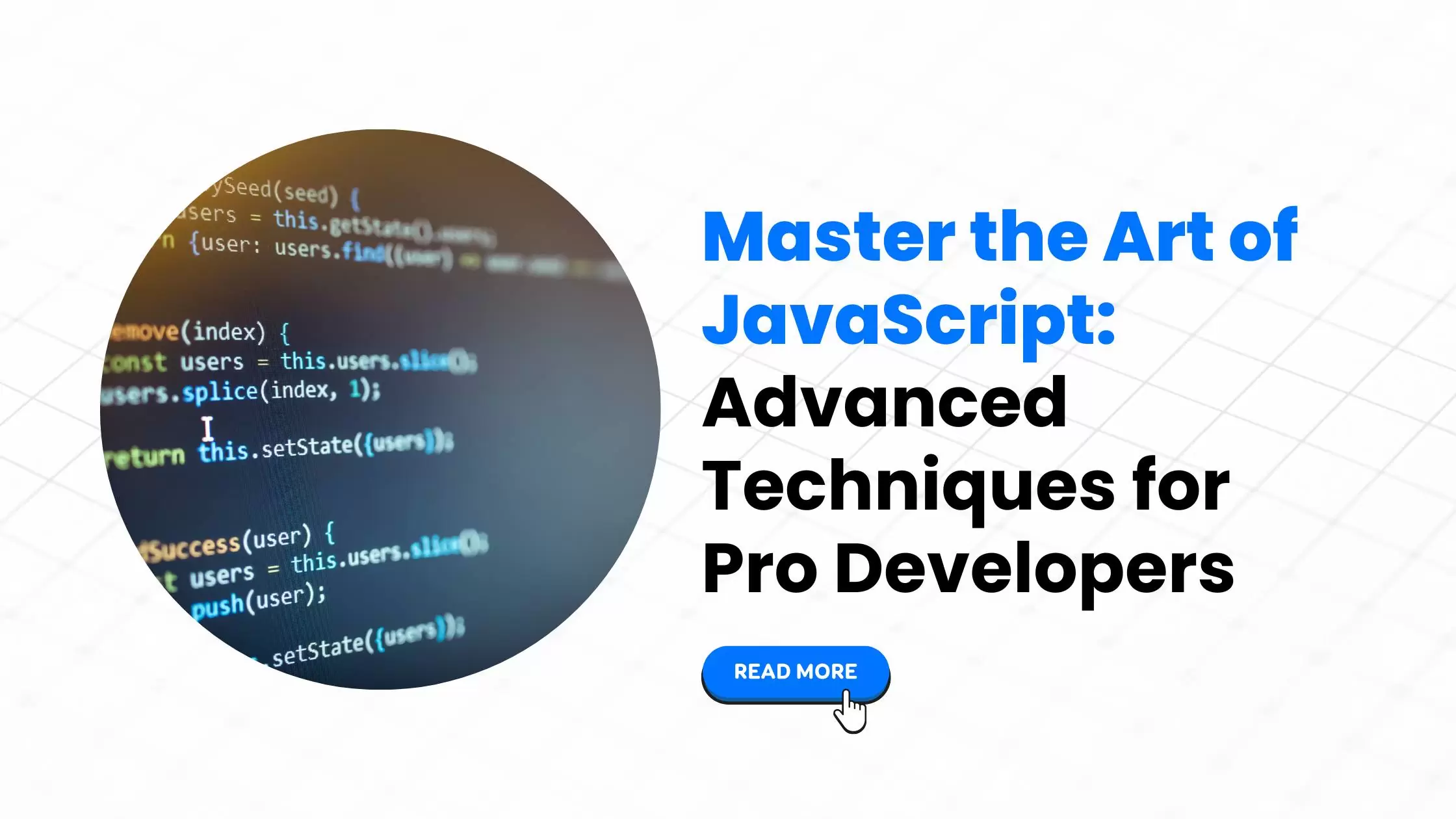Advanced JavaScript Techniques to Take Your Web Development Skills to the Next Level

JavaScript, the ubiquitous web scripting language, has come a long way since its humble beginnings. Today, it’s not just about adding dynamic elements to web pages; it’s the cornerstone of complex web applications, single-page applications (SPAs), and even server-side development with Node.js. But mastering the basics is only the first step. To truly elevate your web development skills, you need to delve into advanced JavaScript techniques.
This article explores some of these techniques, equipping you to craft more efficient, maintainable, and performant web applications. We’ll cover:
- Functional Programming Paradigms:
- Asynchronous Programming with Promises and Async/Await:
- Advanced DOM Manipulation and Virtual DOM:
- Module Systems and Code Organization:
- Modern JavaScript Features (ES6+):
By the end, you’ll be well on your way to becoming an advanced JavaScript developer.
1. Functional Programming Paradigms
Functional programming (FP) is a programming style that emphasizes immutability, pure functions, and first-class functions. While JavaScript isn’t purely functional, incorporating FP principles can significantly improve your code.
-
Immutability: Avoid mutating existing data structures. Instead, create new ones with the desired changes. This promotes data consistency and simplifies reasoning about your code.
-
Pure Functions: Functions that always return the same output for the same input, with no side effects. This makes them easier to test, reason about, and compose.
-
Higher-Order Functions (HOFs): Functions that take other functions as arguments or return functions as results. HOFs enable powerful abstractions and code reusability.
Examples:
// Traditional (mutable) approach
let numbers = [1, 2, 3];
numbers.push(4);
// Functional approach (immutable)
const numbers = [1, 2, 3];
const updatedNumbers = [...numbers, 4];
// Pure function for squaring a number
const square = (x) => x * x;
// HOF for mapping an array
const doubledNumbers = numbers.map(square);
2. Asynchronous Programming with Promises and Async/Await
Traditional callback-based asynchronous programming can lead to “callback hell.” Promises and async/await offer cleaner and more manageable ways to handle asynchronous tasks.
-
Promises: Objects representing the eventual completion (or failure) of an asynchronous operation. They provide a mechanism to chain and handle the results of asynchronous operations.
JavaScriptfetch('https://api.example.com/data') .then(response => response.json()) .then(data => console.log(data)) .catch(error => console.error(error));Use code with caution. -
Async/Await: Syntactic sugar over Promises, making asynchronous code look more synchronous. It uses
asyncfunctions andawaitexpressions.JavaScriptasync function fetchData() { const response = await fetch('https://api.example.com/data'); const data = await response.json(); console.log(data); } fetchData();Use code with caution.
3. Advanced DOM Manipulation and Virtual DOM
Efficient manipulation of the Document Object Model (DOM) is crucial for dynamic web applications. Explore advanced techniques and consider virtual DOM libraries for complex UIs.
-
Event Delegation: Attach event listeners to a higher-level element in the DOM hierarchy, improving performance by avoiding unnecessary event listeners on individual elements.
-
Virtual DOM: A lightweight in-memory representation of the actual DOM. Libraries like React use the virtual DOM to efficiently calculate the minimal changes needed in the real DOM, resulting in faster UI updates.
4. Module Systems and Code Organization
As applications grow, code organization becomes paramount. Explore module systems like CommonJS or ES modules to modularize your code and improve maintainability.
-
Modules: Reusable units of code that encapsulate functionality and data. Module systems provide a way to define modules, import and export them from other modules.
-
Module Bundlers: Tools like Webpack or Rollup can bundle multiple modules into a single file, making them easier to include in web pages.
5. Modern JavaScript Features (ES6+)
The ECMAScript (ES) standard keeps evolving, adding new features that enhance JavaScript’s capabilities. Here are some key features from ES6 and beyond:
-
Classes: Provide a more structured way to define object-oriented constructs, making code more readable and maintainable.
-
Destructuring Assignment: A concise syntax for extracting values from objects or arrays.
-
Spread Syntax: Allows you to expand iterables (like arrays or objects) within other expressions.
-
JavaScript
const numbers = [1, 2, 3]; const allNumbers = [0, ...numbers, 4]; // [0, 1, 2, 3, 4] const person = { name: 'Alice', age: 30 }; const details = { ...person, city: 'New York' }; // { name: 'Alice', age: 30, city: 'New York' }Use code with caution.- Arrow Functions: Concise syntax for defining functions, often used for anonymous functions.
JavaScriptconst numbers = [1, 2, 3].map(x => x * 2); // [2, 4, 6]Use code with caution.- Template Literals: Allow for string interpolation and multi-line strings with embedded expressions.
JavaScriptconst name = 'Bob'; const greeting = `Hello, ${name}!`; // "Hello, Bob!"Use code with caution.Expertise of Webatlas
While mastering these advanced JavaScript techniques will significantly elevate your web development skills, building exceptional web applications often requires a broader range of expertise. This is where WebAtlas comes in.
WebAtlas is a comprehensive web development agency offering a full spectrum of services to bring your web ideas to life. Our team of skilled professionals possesses not only advanced JavaScript knowledge but also deep experience in:
-
Web Development: From building user-friendly static websites to complex SPAs and web applications, we leverage cutting-edge technologies to provide robust and performant web developent services.
-
Mobile App Development: Whether you need a native iOS or Android app, a cross-platform solution, or a progressive web app (PWA), we deliver high-quality mobile applications that cater to your specific needs and target audience.
-
Product Development: We take a holistic approach to product development, combining design thinking, user experience (UX) expertise, and robust development practices to create innovative and user-centric digital products.
-
Software Testing: Our rigorous testing methodologies ensure your web applications and mobile apps are bug-free, secure, and deliver a seamless user experience across various devices and browsers.
By partnering with Webatlas, you gain access to a team of experts who can handle all aspects of your web development project, from initial concept to deployment and ongoing maintenance. We leverage advanced JavaScript techniques alongside other cutting-edge technologies to ensure your web application is not only functional but also performs exceptionally and provides a delightful user experience.
Ready to Take Your Web Development Skills to the Next Level?
We encourage you to explore the world of advanced JavaScript techniques. By incorporating these concepts into your development workflow, you’ll be well on your way to crafting more efficient, maintainable, and scalable web applications.
If you’re looking to build a complex web application or mobile app, WebAtlas is here to help. Contact us today to discuss your project and explore how our comprehensive development services can transform your vision into a reality.
Together, let’s build something remarkable!
Let's talk about your project, or just come and say hello!
Webatlas Technologies is the fastest growing web and mobile app development company



